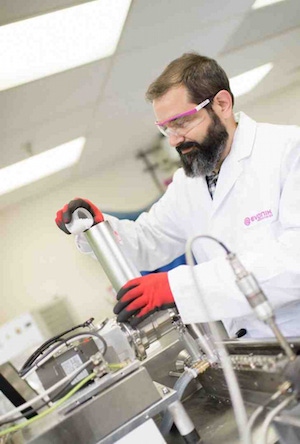June 21, 2016

Biodegradable high-strength composites show tremendous promise as an alternative to metal-based implantable devices used to repair fractured bones. Metallic devices remain in the body permanently or require a second surgical procedure to remove them. By contrast, biodegradable plastics, or bioresorbable materials, as they are often called, leave the patient’s body once the bone has healed. Chemicals company Evonik, headquartered in Essen, Germany, is conducting leading-edge research into this technology at the Medical Devices Project House in Birmingham, AL.
 The materials under investigation consist of polymers and substances that naturally occur in bones. While the research is still in its infancy, it has the potential to dramatically improve patients’ quality of life, as they will not need to undergo additional surgery. Specific device designs using these materials may also help bones to regenerate faster, according to Evonik.
The materials under investigation consist of polymers and substances that naturally occur in bones. While the research is still in its infancy, it has the potential to dramatically improve patients’ quality of life, as they will not need to undergo additional surgery. Specific device designs using these materials may also help bones to regenerate faster, according to Evonik.
The head of the project house, Dr. Andreas Karau, works with a team of more than 20 researchers with a long-term focus on regenerative medicine. “We want to create bioabsorbable implants to replace damaged tissues with healthy tissues. Our current work on biodegradable composites is a first step in this direction,” said Karau.
“Our leading position in polylactic acid–based polymers is an excellent foundation for the development of materials and solutions for regenerative medicine,” explained Karau. The polymers break down into carbon dioxide and water, and the degradation time depends on their molecular composition, chain length and crystallinity. The devices can be engineered to last a few weeks or several months, as long as is needed for the bones or other tissues to regenerate.
Evonik’s Resomer polymers currently are used by medical device OEMs to make bioabsorbable screws, pins and small plates. These are primarily used for torn ligaments in the knee or shoulder, and for the fixation of smaller bones in fingers or the face. The materials are not sufficiently strong to be used for large, load-bearing bones, however, and Karau’s team is exploring the use of composite materials for such applications.
The researchers at the Medical Devices Project House are exploring composite materials that reinforce biodegradable polymers with inorganic substances, such as derivatives of calcium phosphate. In addition to strengthening the material, the additives reportedly enhance its biocompatibility. “As the polymers gradually break down, calcium and phosphate can be absorbed into the newly formed bone tissue,” Karau explains.
There is a potentially vast market for high-strength biodegradable materials. Osteoporosis alone is responsible for 8.9 million fractures annually, according to statistics provided by Evonik.
Research is also being conducted into the development of biodegradable polymers that are compatible with 3D printing, allowing for the fabrication of custom implants for individual patients.
“In the long term, we intend to develop polymeric scaffolds that could be colonized with living cells, creating a true biological implant,” adds Karau. This approach would make it possible to regenerate cartilage, for example, or to replace damaged heart tissue with healthy tissue. However, the researchers first must find ways to improve the materials’ biocompatibility.
The team of scientists in Birmingham are part of Creavis, Evonik’s strategic innovation unit, and work collaboratively with polymer specialists from the Health Care and Performance Materials business lines. They are also investigating biocompatible plastics used in Evonik’s Vestakeep implant product line. Evonik’s medical technology portfolio currently comprises Resomer and Vestakeep implant materials and Vestamid Care, polyamide resins used for molding catheters and similar items.
The Creavis Project Houses typically concentrate on a defined field for a period of three years, and collaborate with multiple business lines. Once the project draws to a close, the researchers return to their respective business lines, one of which markets the resulting products and technologies. Since 2000, Evonik has established a total of eleven Project Houses.
About the Author(s)
You May Also Like




